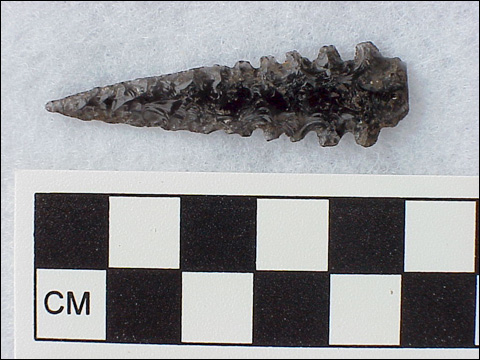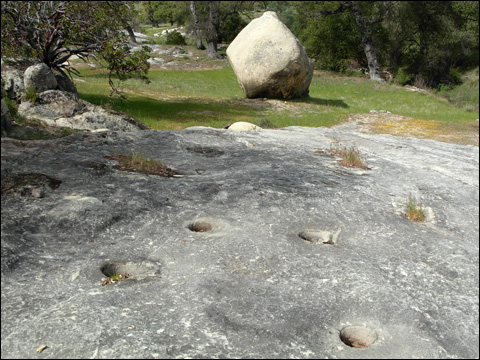
MINERAL RESOURCES
Pigments
Cinnabar: This mineral is the ore of mercury. It produces a bright red pigment. It was mined at New Almaden Mines near San Jose and was traded with neighboring groups (Heizer & Elsasser 1980:152).
Ochre: Ochre can be found in the Berkely Hills and along beaches north of Monterey (author’s experience). At Emeryville, archaeologists learned something about Ohlone burials. The body was often covered with a powder or paste of ochre (Website:City of Emeryville-South Bayfront Project).
Chert: This stone is represented in Ohlone archaeological sites in debutage and as arrow points (Bean 1994:263). This cryptocrystaline, sedimentary, silicate rock is of varying quality. When found without cracks, flaws and of sufficient quality, it has a conchoidal fracture. High quality chert can be worked to produce extremely resilient bifaces for arrows or knives. It is more difficult to work than obsidian, and seldom has the highly perfected form of obsidian knives or arrow points. It is available within the territory of the Ohlone.
Obsidian: Obsidian is not a local resource, but was acquired by trade. Obsidian was traded throughout much of the state. The nearest source was from Mount St. Helena in Napa County, where the variety called “Napa Black” was available from the Wappo Peoples. This type of obsidian is of a very workable grade, and was apparently preferred by many Ohone (Bean 1994:263).
A distinctive style of stone point often seen in Ohlone archeological sites is the “Stockton Point”, a highly crafted style with serrated edges and long tapered point.

Obsidian Stockton point
(URS-1787 from http://emeryville.wli.net/gallery/gallery5/disk5/disk_5.htm)
One unique Stockton point style is the “Stockton Curve”, a sickle-shaped obsidian point with notching designed to be mounted on a shaft of some kind. I have found no documentation of its purpose.
Clay: Clay pottery was not made by Central California Indians. Eastern Pomo used hardened clay balls as ammunition for their slings when hunting mud hens (coot) in Clear Lake (Jacknis 2004:27). Clay was added to acorn mush by Pomo to neutralize bitter tannins (Heizer & Elsasser 1980:100, 152). I have not found references of the use of clay by Ohlone Peoples.
Salt: It can been speculated that the Ohlone made use of shallow tidal lands with natural salt pans to gather salt for their own use and for trade. However, I have yet to find a reliable reference for this. There is a reiiable reference to the collection of salt from saltgrass.
Sandstone mortars: Sandstone was used as an abrasive and is commonly the stone associated with bedrock mortars used in processing food. Two types of bedrock mortars are seen in Ohlone archaeological sites. One is shallow and U shaped and the other is deeper and V shaped. Since acorn is oily and compacts into a paste-like substance when pounded, deep holes are impractical for processing acorn. It is suggested that the deeper V shaped mortar holes were used for processing seeds and berries. A similar division of mortar types is noted among the Sierra Miwok and Mono Peoples (Bean 1994:46-47).

Bedrock mortars
LAND MANAGEMENT
The conventional view of California’s hunter-gatherer societies implies people gathered from a rich and abundant ecosystem. Although this is true, it does not acknowledge the fact natural plant succession would have changed the productive land California Indians enjoyed into a much less productive environment if Native Peoples hadn’t used fire regularly to alter the landscape. Regular burning reduced fuel load and made fire less unpredictable and devastating. Fire was relied upon to increase grassland areas and grass seed production. It cleared coastal scrub and chaparral, allowing for both easier hunting access, and improved browse for game animals. It destroyed pests of oak, overwintering in dead leaves and reduced competitive growth in the understory. It allowed basketry plants to produce long, useable shoots. It cleared grasses, allowing edible bulbs and the seed producing plants like chia and red maids to flourish. Also, a study of the botany of ancient campsites shows Indians did disperse grass and fruit producing shrubs and trees. And, though hunting might reduce local numbers of game animals, the overall numbers of animals were not apparently affected. The productive landscape described by the first Spanish missionaries was not actually one entirely of nature’s design, but rather the result of purposeful manipulation by its human inhabitants (Bean 1994:303), (Heizer & Elsasser 1980:113, 183-184).
REFERENCES
Bean, Lowell John
1994 The Ohlone Past and Present, Menlo Park: Ballena Press
Bocek, Barbara R.
1984 Ethnobotany of Coastanoan Indians, California,
Based on Collections by John P. Harrington Econonmic Botany 38(2)
Brown, Vinson & Andrews, Douglas
1969 The Pomo Indians of California and Their Neighbors, Edited by Albert Elsasser, Naturegraph Publishers, Healdsburg, CA
Fuller, Thomas C. and McClintock, Elizabeth
1986 Poisonous Plants of California, Berkeley, Los Angeles, London: University of California Press
Gayton, Anna H.
1948 Yokuts and Western Mono Ethnography, Berkeley, CA: University of California Press
Gifford, Edward W.
1936 California Indian Balanophagy. In Essays in Anthropology Presented to Alfred L. Krober, ed. Robert H. Howie, 87-98. Berkeley: University of California Press.
Goldschmit,Walter R.
1974 Preparation of (Hupa) Acorn Soup. In Indian Land Use and Occupancy in California, eds Ralph L. Beals and Joseph A. Hester, Jr., 1:311-13. New York: Garland Publishing
Heizer, Robert F. & Elsasser, Albert B.
1980 The Natural World of the California Indians, Berkeley: University of California Press
Hickman, James C., Editor
1993 The Jepson Manula Higher Plants of California, Berkeley: University of California Press
Ingles, Lloyd G.
1947 Mammals of the Pacific States, Stanford: Stanford University Press
Jacknis. Ira
2004 Food in California Indian Culture, Berkeley: Phoebe Hearst Museum of Anthropology University of California
Kaufman, Kenn
1996 Lives of North American Birds, Boston, New York: Houghton Mifflin Company
Kroeber, Alfred L.
1925 Handbook of the Indians of California, Bureau of Ethnology Bulletin, no. 78. Washington, DC: Smithsonian Institution
Latta, Frank F.
1949 Handbook of Yokuts Indians, Bakersfield, CA, Kern County Museum
Loeb, Edwin M.
1926 Pomo Folkways, UC Publications in American Archaeology and Ethnology, 19 (2):149-405 Berkeley University of California Press
Mathewson, Margaret Susan
1998 The Living Web: Contemporary Expressions of California Indian Basketry, dissertation at the University of California, Berkeley
Mayfield, Thomas Jefferson
1929 Indian Summer Traditional Life Among the Choinumne Indians of California’s San Joaquin Valley, 1993 Heyday Books, Berkeley, CA
Ortiz, Beverly R. as told by Julia F. Parker
1991 It will Live Forever, traditional Yosemite Indian Acorn Preparation, Berkeley: Heyday Press
1991 Xerox handout-reference generated at Coyote Hill Regional Park and listed as information from Bocek 1984 article
Powers, Stephen
1976 Tribes of California, Berkeley, University of California Press
Ralph Shanks and Lisa Woo Shanks, Editors
2006 Indian Baskets of Central California Art, Culture, and History, Novato, CA, Costaño Books in association with MAPOM
Stevens, Michelle L. and Ryan, Andrea
1997, Healing the Land, Healing the People A Guidebook to the Ethnobotany of the Putah and Cach Creeks Eco-Region, UC Davis Reprographics
Timbrook, Jan
2007 Chumash Ethnobotany, Berkeley, Heyday Books
Weyrauch, Rita
1982 Herbal Remidies Solstic Journal I (I):1-27, Santa Barbara Indian Center
Websites:
Bennyhoff, James A.
Website: http://www.californiaprehistory.com/reports01/rep0008.html
2010 Symposium: A New Look at some Old Sites, Papers from the Symposium Organized by Francis A. Riddell, Presented at the Annual Meeting of the Society for California Archaeology, March 23-26, 1983, San Diego, California. Coyote Press Archives of California Prehistory 6:65-74, 1986.
Broughton, Jack
2010 at http://www.physorg.com/news10821.html
University of Utah
Chestofbooks.com
2010 http://chestofbooks.com/gardening-horticulture/Hardy-Trees-Shrubs-And-Herbaceous-Plants/4-Cyclobothra.html
City of Emeryville Bayfront Project
2010 Website http://emeryville.wli.net/kids/kids_intro2.htm
http://emeryville.wli.net/gallery/gallery5/disk12/disk_12.htm
USDA National Resource Conservation website
2010 http:// www.plants.usda.gov/plantguide/doc/cs_irfe.doc
Wikipedia
http://en.wikipedia.org/wiki/Cyperus_esculentus
![]()
Photographs by Susan Labiste. All photo rights reserved.
We hope the information on the PrimitiveWays website is both instructional and enjoyable. Understand that no warranty or guarantee is included. We expect adults to act responsibly and children to be supervised by a responsible adult. If you use the information on this site to create your own projects or if you try techniques described on PrimitiveWays, behave in accordance with applicable laws, and think about the sustainability of natural resources. Using tools or techniques described on PrimitiveWays can be dangerous with exposure to heavy, sharp or pointed objects, fire, stone tools and hazards present in outdoor settings. Without proper care and caution, or if done incorrectly, there is a risk of property damage, personal injury or even death. So, be advised: Anyone using any information provided on the PrimitiveWays website assumes responsibility for using proper care and caution to protect property, the life, health and safety of himself or herself and all others. He or she expressly assumes all risk of harm or damage to all persons or property proximately caused by the use of this information.
© PrimitiveWays 2016